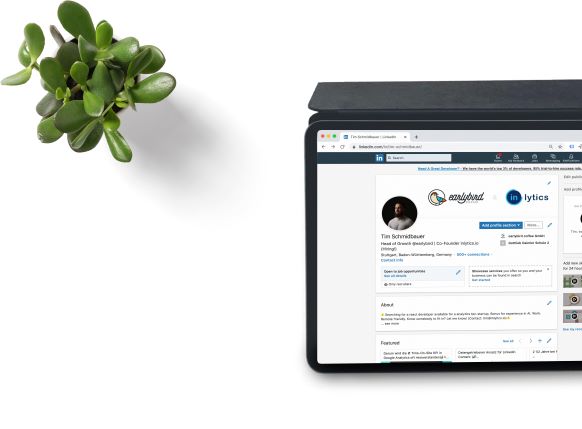A LinkedIn profile allows you to gain more exposure with the people and businesses across industries that may lead to new job opportunities. With a professional profile, you can put your talent and qualifications out there for all to see. But it’s so much more than that.
There are several advantages to creating a LinkedIn profile, including the connections. Sprout Social states that LinkedIn has over 910 million active monthly users and with such a huge pool of professionals, can make your current job easier too. Think of the old days of networking in person – now we’re doing this online, and LinkedIn is the place to be.
As the largest professional network, LinkedIn is an opportunity to build your business reputation, broaden your professional network and help others know exactly who you are and what you do.
To maximise the potential of your profile we’ve got a few tips on how to set a LinkedIn profile up, as well as some things you can do to make sure others are looking at it.

Why You Need a LinkedIn Profile
A LinkedIn profile can be likened to your professional landing page. It has your career summary, your interests, and your background. Don’t fall into the trap of thinking “I’m not professional enough yet” or “I haven’t had enough experience yet”. LinkedIn is a great way to let others know you’re ready to take on a new challenge or enter a new field of work. Think of LinkedIn as an easy and more targeted way to network, engage with your contacts and share your skills with the right people. And that includes possible future employers.
Professional achievements
There is no better place to celebrate and showcase your success than on your LinkedIn profile. Your professional achievements such as anniversaries, promotions, and new jobs can be seen by your connections. Displaying your achievements helps in network building as your connections will celebrate with you.
Also, when you display your personal achievements, you can easily track your milestones. By doing this, you’re motivating yourself to do better, whether educationally or professionally. To cap it off, updating your personal achievements gives you more exposure within your network.
Brand management
Yes, the word ‘brand’ may make you cringe, but we can’t emphasise this enough. There’s no better way to manage your personal brand than having a profile on LinkedIn. With a LinkedIn profile, you can manage your brand, seeing that you have full control over how it’s run.
Also, you can manage the way the professional world experiences your views, qualifications and professional experience. Feel free to make custom changes to your profile whenever you wish. Having a customised profile also helps prospective recruiters to understand you better.
Get exposure
Globally, a huge chunk of recruiters use LinkedIn to seek their next candidates. If it’s an international opportunity you seek, LinkedIn has millions of users from over 200 countries.
Knowing how to create a LinkedIn profile is your key to opportunity. With a professional LinkedIn profile, you can be seen by the right people for the right jobs and educational opportunities.
How To Create a LinkedIn profile
Creating a profile on LinkedIn may seem a little overwhelming if you’ve never used the platform before. But it doesn’t have to be hard. You can start simply and add more information over time.
In a step-by-step format, we’ll guide you on how to create a LinkedIn profile.
Step one: The basics
Don’t make the mistake of just using a random email address. It’s imperative that you use an email you check often. Using an email address you check regularly means you’ll be able to see all your LinkedIn notifications immediately when they come in. This could mean messages from potential recruiters, invitations to connect from people in your business network, job alerts, and more.
Include a mobile number allows recruiters to connect with you directly. You can permit LinkedIn to access your contact list. It allows you to connect with your existing contacts who are already on LinkedIn.
Additionally, LinkedIn will ask for your employment status. If you’re a job seeker, you can use phrases that show you’re seeking employment opportunities.
Step 1: Select an account type
LinkedIn offers a free as well as a premium option which has more features. Usually, the free option is fine to get you started. You can consider upgrading at a later time depending on how you use it and what you want to achieve.
Step 2: Add a headshot
The biggest tip here is to use the best professional looking photo of yourself that you can. That doesn’t mean you have to go out and pay for a photo shoot (although that’s OK too), but it does need to look professional.
Make sure it’s clear, is just your head and shoulders and you’re professionally dressed (no party pics please!).
Step 3: Add your experience
For jobseekers wanting to know how to create a LinkedIn profile, this step is particularly important. List your job experiences both past and current in this section. You have the option of manually adding your experiences or importing a resume. Either way, ensure that it highlights your strengths and accomplishments so that potential employers can see them.
Don’t downplay the use of keywords. Use keywords to help prospects find you easily. Don’t forget to begin with the most recent job experience. Also, try to make your experience engaging for readers and an example of your personal voice.
Step 4: Add your skills
Adding relevant skills to your profile displays your abilities to prospects. It gets better if your connections endorse your skills. Not only does it show you’re indeed good at them, it increases your discoverability.
Also, LinkedIn has skill assessment tests that you can take. They show how proficient you are in the skills you added. When prospects see how proficient you are, you have a higher chance of getting a job.
Step 5: Write an attractive headline
More often than not, many people new to the platform ask, “what is a LinkedIn headline?” Many people are unaware of the importance of the headline, so they leave it empty. The best LinkedIn profiles have attractive headlines.
Don’t just write where you work and your position in the company, write what you’re good at, what you’re working on, or a recent accomplishment. A headline is more than your title or job position. As a job seeker, utilise this space and showcase your abilities. Once you can do this well, your profile will stand out.
Step 6: Your ‘About’ section
This section is the part of your LinkedIn profile that allows recruiters and educational authorities to get a sense of who you are as a person. In essence, this summary allows you to express yourself in words, so make the best of it.
The trick is to keep it to one or two paragraphs. It also needs to be relevant, so don’t include every single thing you’ve ever done or dreamed of doing. If your goal is to get a job in a different industry, talk about any courses you’ve done and the transferable skills you have that will make you a good candidate.
Step 7: Upload your resume (optional)
You can upload your resume to LinkedIn. You can choose to either upload it to a specific job application or you can display it on your profile. If you do display it on your profile, make sure you keep it updated and relevant.
Standing Out
After learning how to create a LinkedIn profile, you need to know how to make it stand out.
- Proof read it before publishing
- Add recommendations
- Post regularly
- Share your published works
- Join groups
- Get more connections
- Use numbers and bullet points when writing your summary
- Avoid making your summary dull
- Show enthusiasm
- Showcase your achievements
- Add a profile video
- Create a professional portfolio
Use it the right way
Like most social media platforms you get the best results when you give your profile or account a bit of attention and care.
LinkedIn is not a set and forget situation. If you want LinkedIn to work for you, you’ll need to put in a little time. It doesn’t have to be a lot of time but if you have a consistent approach to your activity, then you’re more likely to see benefits.
To increase your chances of finding your dream job there are a few things you can do:
Make connections
The more connections you have on LinkedIn, the more visible your profile is. People with more connections are more likely to appear in search results
Connect with people who work in similar roles or who might work in a company you admire or in your industry. You can start by connecting with people you know as well as old contacts like school friends or ex-colleagues.
Plus you can request connections with people you may have started following or whose content you like.
Include keywords
Including keywords in your headline, summary, and job titles is a good idea. They can help recruiters who search to find you more easily. Look at job descriptions or position vacant ads for the industry you’re interested in and list relevant keywords in your profile.
Get active
Commenting, sharing articles, interacting with groups, or even liking a post keeps you engaged and shows that you’re an active user. People will then be more likely to want to connect with you.
Once you get more comfortable with LinkedIn it’s a good idea to post content too. It’s a great way to boost your personal brand and give others more insight into your skills.
Qualifications Help Your Brand On LinkedIn
You can get more recognition on LinkedIn if you have qualifications. Check out our online courses here and get in touch to chat about your future.
Your first step is to take a look at the courses we offer and see which ones spark interest. Then get in touch with one of our Course Consultants who can help you with the best options for your goals.





